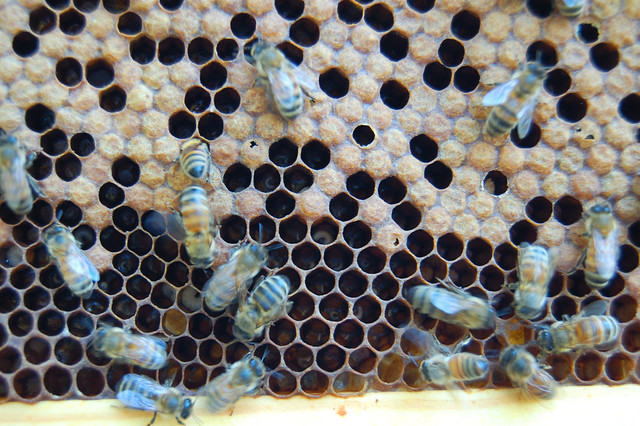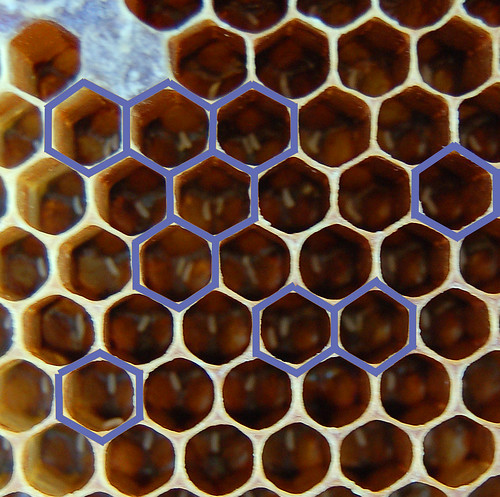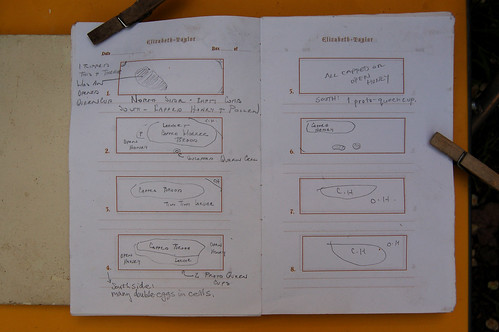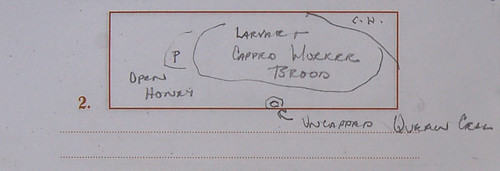Inside the QE2
...

I'm taking a few days off of work, and today I spent most of my time in the garden. It was a lovely day, the weeds were beckoning.
It also seemed like a good day for a hive inspection. On March 27th, we split the Gloriana colony into two hives. Gloriana was going crazy, and we had lost the Elizabeth Taylor colony over the winter.
Robb had read up on "bee math" and figured the following:

If you look closely, you'll see that we found eggs, larvae of various sizes, and capped brood cells. Worryingly, we also noticed tiny holes in the wax covering the developing pupae. I interpret this as a sign that the colony is still infested with parasitic varroa mites.

Another observation we made is that multiple eggs are being laid in individual brood cells. (Look in the cells outlined in blue. And don't judge my lousy photoshop skills.)
This seems to be a sign of a queen who hasn't quite figured things out, or to be really scientific, who hasn't got her groove on yet.
I'm choosing not to worry about this. Since the queen is the only female bee in the entire colony who has sex, only her eggs are fertilized. The queen is apparently able to control whether or not she lays a fertilized female worker egg or an unfertilized egg that will develop into a male drone bee.
If we had no queen in our colony, and instead had what's called a "laying worker" all of the brood in the colony would be drone brood, which has a different appearance than what we're observing. (Drones are larger, so the tips of their cells protrude further from the wax surface.)

We try to keep notes about what's going on inside our colonies. We've learned that our memory isn't to be trusted. Recording our observations is valuable in tracking the progress of the bees.
Robb designed and bound a number of books for making notations during hive inspections. We do quick drawings, and record what's going on inside the hive.

Of course, all of the notes and drawings are made while wearing heavy duty gloves.
It really does help to make notes. I can't tell one photo from the next sometimes, and honestly, I don't have time to sift through all those pictures. Plus, a photo doesn't always show details very clearly.
This is the drawing of the second frame on the upper hive box of the QE2 hive. It indicates that there's open and capped worker brood in the center of the frame. To the left of the brood is a patch of pollen, and all of that is encircled by a lot of open cells of unfinished honey. In the top corner is honey that has the correct water levels, which the bees have capped with wax. And at the bottom of the drawing, I've noted that the bees had started building a special structure that might be intended to house a developing queen bee.

For comparison's sake, here's a photograph of that same frame.
It's much easier to work with a small booklet, instead of trying to muck around with pictures on the computer. I don't care if I drop the book on the ground, or if the book gets sticky with honey. I'd be pretty annoyed if I did the same thing to my computer.
Sometimes the simplest methods are the best.
Do you remember that we named our first hive Gloriana, because our colony's queen was a young virgin from an afterswarm? "Gloriana" was a name assigned to Queen Elizabeth I of England, who ruled as a virgin queen. When we split the hive, we were trying to think of another suitable name. As the real Elizabeth Taylor has recently died, using her name again seems inauspicious.
Robb christened the new hive the QE2, which cracks me up. I'm very lucky to have someone who shares my idiotic sense of humor.

I'm taking a few days off of work, and today I spent most of my time in the garden. It was a lovely day, the weeds were beckoning.
It also seemed like a good day for a hive inspection. On March 27th, we split the Gloriana colony into two hives. Gloriana was going crazy, and we had lost the Elizabeth Taylor colony over the winter.
Robb had read up on "bee math" and figured the following:
If the egg that becomes a queen was laid on March 27th, she would emerge around April 8th, mate around April 18th and lay her first eggs around April 24th.
The first new workers would emerge from their brood cells on May 13th. These bees would leave the hive for the first time after June 5th.

If you look closely, you'll see that we found eggs, larvae of various sizes, and capped brood cells. Worryingly, we also noticed tiny holes in the wax covering the developing pupae. I interpret this as a sign that the colony is still infested with parasitic varroa mites.

Another observation we made is that multiple eggs are being laid in individual brood cells. (Look in the cells outlined in blue. And don't judge my lousy photoshop skills.)
This seems to be a sign of a queen who hasn't quite figured things out, or to be really scientific, who hasn't got her groove on yet.
I'm choosing not to worry about this. Since the queen is the only female bee in the entire colony who has sex, only her eggs are fertilized. The queen is apparently able to control whether or not she lays a fertilized female worker egg or an unfertilized egg that will develop into a male drone bee.
If we had no queen in our colony, and instead had what's called a "laying worker" all of the brood in the colony would be drone brood, which has a different appearance than what we're observing. (Drones are larger, so the tips of their cells protrude further from the wax surface.)

We try to keep notes about what's going on inside our colonies. We've learned that our memory isn't to be trusted. Recording our observations is valuable in tracking the progress of the bees.
Robb designed and bound a number of books for making notations during hive inspections. We do quick drawings, and record what's going on inside the hive.

Of course, all of the notes and drawings are made while wearing heavy duty gloves.
It really does help to make notes. I can't tell one photo from the next sometimes, and honestly, I don't have time to sift through all those pictures. Plus, a photo doesn't always show details very clearly.
This is the drawing of the second frame on the upper hive box of the QE2 hive. It indicates that there's open and capped worker brood in the center of the frame. To the left of the brood is a patch of pollen, and all of that is encircled by a lot of open cells of unfinished honey. In the top corner is honey that has the correct water levels, which the bees have capped with wax. And at the bottom of the drawing, I've noted that the bees had started building a special structure that might be intended to house a developing queen bee.

For comparison's sake, here's a photograph of that same frame.
It's much easier to work with a small booklet, instead of trying to muck around with pictures on the computer. I don't care if I drop the book on the ground, or if the book gets sticky with honey. I'd be pretty annoyed if I did the same thing to my computer.
Sometimes the simplest methods are the best.
Do you remember that we named our first hive Gloriana, because our colony's queen was a young virgin from an afterswarm? "Gloriana" was a name assigned to Queen Elizabeth I of England, who ruled as a virgin queen. When we split the hive, we were trying to think of another suitable name. As the real Elizabeth Taylor has recently died, using her name again seems inauspicious.
Robb christened the new hive the QE2, which cracks me up. I'm very lucky to have someone who shares my idiotic sense of humor.
Comments
What do I know though,I've just started down this road. :)
Luckily, we don't have small hive beetles in this part of the country.
I've seen comb that has been infested with wax moths, and I doubt that we have that problem.
However, I'd love to read what you've been reading that lead you to these conclusions. Can you share any information?
Thank you for the bird ID - I was told it was a Towhee by a few other people :). I saw our bluejay pecking it pretty badly today to get it out of the yard...
I fooled around with Hive Tracks, but honestly drawing is more natural for me than data entry.
You are such an utter sweetie pie!
Those Western Scrub Jays are very protective of "their" territory. They are tough, smart, sassy birds.
http://www.bushfarms.com/beeslayingworkers.htm